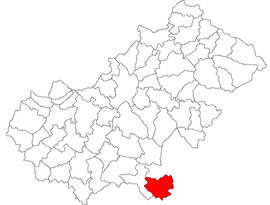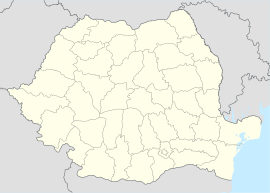
Transylvania is a historical and cultural region in Central Europe, encompassing central Romania. To the east and south its natural border is the Carpathian Mountains and to the west the Apuseni Mountains. Broader definitions of Transylvania also include the western and northwestern Romanian regions of Crișana and Maramureș, and occasionally Banat. Historical Transylvania also includes small parts of neighbouring Western Moldavia and even a small part of south-western neighbouring Bukovina to its north east.

Brașov County is a county (județ) of Romania, in Transylvania. Its capital city is Brașov. The county incorporates within its boundaries most of the Medieval "lands" (țări) Burzenland and Făgăraș.

Sălaj County is a county (județ) of Romania, located in the north-west of the country, in the historical regions of Crișana and Transylvania. It is bordered to the north by Satu Mare and Maramureș counties, to the west and south-west by Bihor County, and to the south-east by Cluj County. Zalău is the county seat, as well as its largest city.

Satu Mare County is a county (județ) of Romania, on the border with Hungary and Ukraine. The capital city is Satu Mare.

Huedin is a town in Cluj County, Transylvania, Romania.

Baia Sprie is a town in Maramureș County, northern Romania. Baia Sprie is situated at a distance of 9 km (5.6 mi) from Baia Mare and belongs to the Baia Mare metropolitan area.

Jibou is a town in Sălaj County, Transylvania, Romania. In 2021 it had a population of 9,677. Jibou includes the town proper and other four villages: Rona, Cuceu (Kucsó), Husia (Hosszúújfalu), and Var (Szamosőrmező).

Vynohradiv is a city in western Ukraine, in Zakarpattia Oblast. It was the center of Vynohradiv Raion and since 2020 it has been incorporated into Berehove Raion. Population: 25,317.
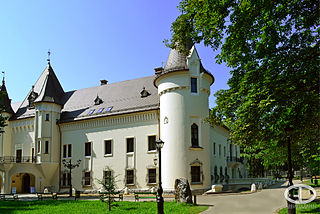
Carei is a city in Satu Mare County, northwestern Romania, near the border with Hungary. The city administers one village, Ianculești.
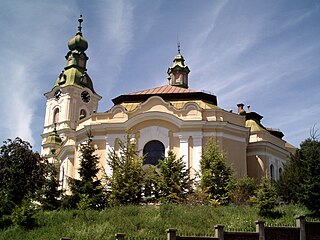
Zalău (Romanian pronunciation:[zaˈləw], unofficial and former official name: Romanian: Zalău is the seat of Sălaj County, Romania. In 2021, its estimated population was 52,359.

Dej is a municipality in Transylvania, Romania, 60 kilometres (37 mi) north of Cluj-Napoca, in Cluj County. It lies where the river Someșul Mic meets the river Someșul Mare. The city administers four villages: Ocna Dejului (Désakna), Peștera (Pestes), Pintic (Oláhpéntek), and Șomcutu Mic (Kissomkút).

Tășnad is a town in Satu Mare County, Crișana, Romania. It administers five villages: Blaja (Tasnádbalázsháza), Cig (Csög), Rațiu (Ráctanya), Sărăuad (Tasnádszarvad), and Valea Morii (Tasnádmalomszeg).

Dârjiu is a commune in Harghita County, Romania. It lies in the Székely Land, an ethno-cultural region in eastern Transylvania. The commune is composed of two villages, Dârjiu (Székelyderzs) and Mujna (Székelymuzsna), both of which are on the route of the Via Transilvanica long-distance trail.

Sângeorgiu de Pădure is a town in Mureș County, Transylvania, Romania. Bezid (Bözöd), Bezidu Nou (Bözödújfalu), and Loțu (Lóc) villages are administratively part of the town.

Gheorghe Doja is a commune in Mureș County, Transylvania, Romania composed of five villages: Gheorghe Doja, Ilieni (Lukailencfalva), Leordeni (Lőrincfalva), Satu Nou (Teremiújfalu), and Tirimia (Nagyteremi).

Beltiug is a commune of 3,228 inhabitants situated in Satu Mare County, Transylvania, Romania. It lies on the banks of the Crasna River south of Ardud, 35 km south of the county seat, Satu Mare, along the main road E81. It is today one of the most important cultural centres of the Sathmar Swabian community.

Coșeiu is a commune located in Sălaj County, Crișana, Romania. It is composed of three villages: Archid (Szilágyerked), Chilioara (Szilágykirva), and Coșeiu.

Măeriște is a commune located in Sălaj County, Crișana, Romania. It is composed of six villages: Criștelec (Kerestelek), Doh (Doh), Giurtelecu Șimleului (Somlyógyőrtelek), Măeriște, Mălădia (Maladé), and Uileacu Șimleului (Somlyóújlak).
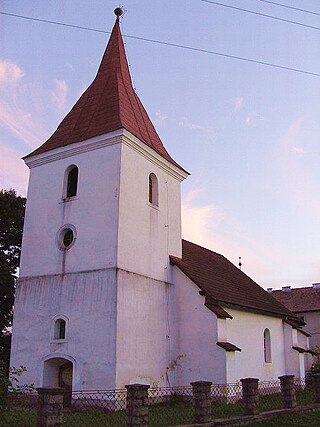
Nimigea is a commune in Bistrița-Năsăud County, Transylvania, Romania, with 5,324 residents. It is composed of eight villages: Florești (Virágosberek), Mintiu (Oláhnémeti), Mititei (Mittye), Mocod (Szamosmakód), Mogoșeni (Szamosmagasmart), Nimigea de Jos, Nimigea de Sus (Oláhnemegye), and Tăure (Tóhát).

Șeica Mare is a commune located in Sibiu County, Transylvania, Romania. It is composed of six villages: Boarta, Buia, Mighindoala, Petiș, Șeica Mare, and Ștenea. Calvaser was also a village until the late 20th century, when it was absorbed by Șeica Mare village.

